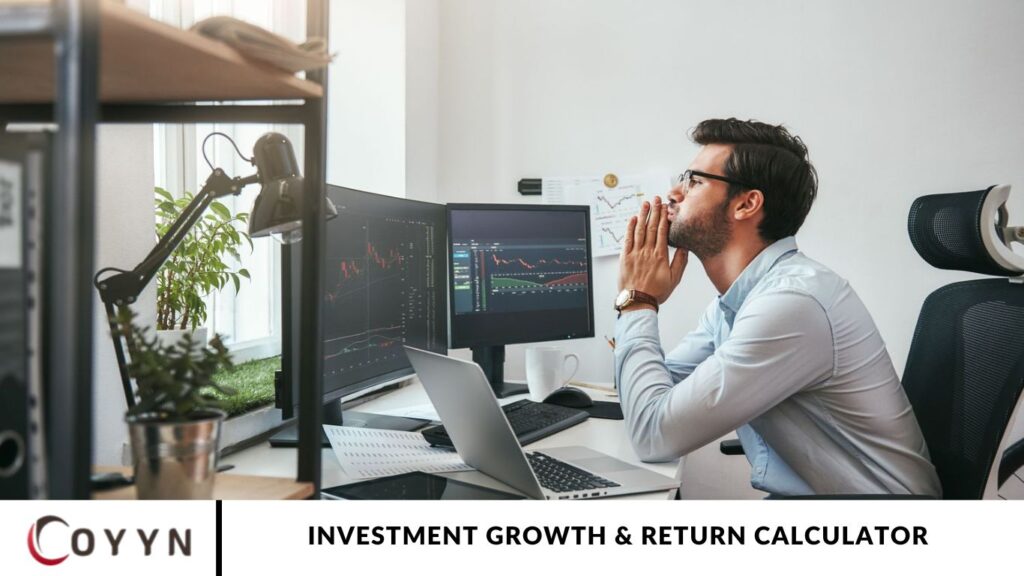Investing wisely requires a clear understanding of how your money can grow over time. The Investment Growth & Return Calculator is a powerful tool designed to help you estimate potential returns on your investments based on factors like initial capital, contribution frequency, interest rates, and investment duration.
This calculator allows you to visualize the impact of compound interest, assess different investment strategies, and make informed financial decisions. Whether you’re planning for retirement, saving for a significant purchase, or exploring wealth-building opportunities, this tool provides valuable insights into your financial future.
| Year | Starting Amount | Annual Contribution | Total Contributions | Interest Earned | Total Interest Earned | End Balance |
| 2025 | $5,000 | $100 | $100 | $200 | $200 | $5,300 |
| 2026 | $5,000 | $100 | $200 | $212 | $412 | $5,612 |
| 2027 | $5,000 | $100 | $300 | $224 | $636 | $5,936 |
| 2028 | $5,000 | $100 | $400 | $237 | $874 | $6,274 |
| 2029 | $5,000 | $100 | $500 | $251 | $1,125 | $6,625 |
| 2030 | $5,000 | $100 | $600 | $265 | $1,390 | $6,990 |
| 2031 | $5,000 | $100 | $700 | $280 | $1,669 | $7,369 |
| 2032 | $5,000 | $100 | $800 | $295 | $1,964 | $7,764 |
| 2033 | $5,000 | $100 | $900 | $311 | $2,275 | $8,175 |
| 2034 | $5,000 | $100 | $1,000 | $327 | $2,602 | $8,602 |
Investment Calculator
Whether you’re new to investing or an experienced investor, an investment calculator can help you plan and achieve your financial goals. It allows you to see how factors like your initial investment, contribution frequency, and risk tolerance influence the growth of your money over time.
Below, we’ll explore the fundamentals of investing, potential risks to be aware of, and key factors to consider before putting your money to work.
If you need personalized guidance, a financial advisor can help you build and manage your investment portfolio. You can use SmartAsset’s free online matching tool to find an advisor in your area.
How Investing Works
Investing allows you to put your unused money to work, helping it grow over time. When you invest in stocks and bonds, you’re not only supporting companies or governments but also benefiting from compound interest. Over time, compound interest can transform small savings into substantial wealth—provided you make informed choices and avoid common investing mistakes.
Becoming an investor doesn’t mean you need to research individual companies and actively trade stocks. In fact, studies suggest that this approach rarely leads to consistent returns. For those with limited time for financial management, low-cost index funds can be a simple and effective way to invest.
People often invest to achieve long-term financial goals, such as buying a home, funding a child’s education, or building a comfortable retirement. Common types of financial investments include:
- Stocks: Shares of a company that may increase in value as the company grows. Stocks carry higher risk but offer the potential for greater returns.
- Index Funds: A collection of stocks or bonds that track a market index, offering a cost-effective, long-term investment strategy.
- Exchange-Traded Funds (ETFs): A diversified investment that blends features of stocks and index funds, allowing for easy trading and typically lower fees.
- Mutual Funds: A pooled investment in stocks, bonds, and other securities managed as a single entity. Mutual funds are often used for retirement and long-term financial growth.
How to Calculate Return on Investment (ROI)

Return on Investment (ROI) is a key metric used to measure the profitability of financial investments such as stocks, mutual funds, index funds, and ETFs.
To calculate ROI, subtract your initial investment amount from the final value of your investment. Then, divide that result by the initial cost of the investment and multiply by 100 to express it as a percentage.
While ROI helps assess an investment’s potential profitability, it does not factor in the time the asset is held. Since investment returns can vary over different timeframes, it’s essential to consider your time horizon and financial goals when evaluating potential earnings.
Factors to Consider Before You Invest
All investments come with some level of risk, so it’s essential to evaluate how various factors can impact performance. When making investment decisions, consider these five key factors to maximize potential returns.
Risk and Return on Investments
As you approach retirement, your investment portfolio becomes more sensitive to market fluctuations. Traditional advice suggests that older investors should reduce risk by shifting a portion of their portfolio from stocks to bonds.
Investing always involves a trade-off between risk and return—higher potential returns come with greater risk, while safer investments may struggle to outpace inflation. Striking the right balance in asset allocation depends on one’s age, financial goals, and risk tolerance.
Starting Balance for Investments
If you have savings set aside, received a work bonus, or inherited money, that amount can serve as your investing principal. Your principal, or initial balance, acts as the foundation for your investments.
Many brokerage firms require a minimum investment of a few hundred dollars to $1,000 or more for mutual funds and index funds. However, individual stocks and bonds can often be purchased with a smaller starting amount.
Contributions for Investments
After making your initial investment, you’ll likely continue adding to it over time. The amount you regularly invest is known as your contribution, and it can vary based on your saving style. Some people make aggressive budget cuts to maximize their contributions, while others prefer a more gradual approach.
You also have flexibility in how often you contribute. Many investors set up automatic deductions from their income, making contributions monthly or biweekly, depending on their pay schedule. Others may invest once a year, based on their financial situation and goals.
Rate of Return on Investments
Once you’ve determined your starting balance, contribution amount, and contribution frequency, your money is now subject to market fluctuations. But how can you estimate your potential return?
SmartAsset’s investment calculator defaults to a 4% return, which may seem low compared to the stock market’s long-term average returns. However, this estimate assumes a diversified portfolio with a mix of stocks, bonds, and cash, each with different rates of return and market fluctuations.
Using a conservative rate of return helps ensure you save enough for your future. While a 10% return might sound appealing, relying on overly optimistic projections could lead to under-saving—and, ultimately, financial insecurity down the road.
Years to Accumulate for Investments
The final factor to consider is your investment time frame—the number of years you plan to keep your money invested before you need to access it. The longer your investment horizon, the more you can benefit from the power of compound interest.
This is why it’s crucial to start investing early in your career rather than waiting until later in life. Investing isn’t just for older, wealthy individuals—anyone can start, and many mutual funds require only a small initial investment. The earlier you begin, the more time your money has to grow.
Frequently Asked Question
What is an Investment Growth & Return Calculator?
An Investment Growth & Return Calculator helps estimate how your investments could grow over time, factoring in your initial investment, contribution amount, investment duration, and expected rate of return.
How do I use the Investment Growth & Return Calculator?
Input your starting balance (initial investment), regular contribution amount, contribution frequency, expected rate of return, and the number of years you plan to invest. The calculator will provide an estimate of your investment growth over time.
What is the default rate of return used in the calculator?
The calculator’s default rate of return is 4%, which is a conservative estimate considering a diversified portfolio of stocks, bonds, and cash.
Can I change the rate of return?
Yes, you can customize the rate of return based on your investment expectations or historical data for specific investment types, such as stocks or bonds.
Why is the default rate of return set to 4%?
A 4% return is a conservative estimate that reflects a balanced portfolio of stocks, bonds, and cash. This helps avoid overestimating potential gains and ensures you save adequately for the future.
What factors affect the growth of my investment?
Key factors include your initial investment, ongoing contributions, the rate of return, and the length of time you plan to invest. Market conditions, inflation, and asset allocation can also influence returns.
How often can I contribute to my investment?
You can choose how frequently you want to contribute to your investment—monthly, quarterly, or annually. The calculator can accommodate different contribution frequencies.
Conclusion
The Investment Growth & Return Calculator is a valuable tool for anyone looking to plan and understand the potential growth of their investments. By inputting your starting balance, contribution amounts, and expected rate of return, you can gain a clearer picture of how your money could grow over time. This helps you make more informed decisions about your financial future, whether you’re saving for retirement, a significant purchase, or any long-term goal.
While the calculator offers estimates, it’s important to remember that actual returns can vary due to market fluctuations, asset allocation, and other factors. Using conservative assumptions can help you set realistic expectations and avoid under-saving. By starting early and contributing regularly, you can take full advantage of compound interest and work toward achieving your financial objectives. For personalized advice, consider consulting an economic advisor to tailor your investment strategy to your specific needs.


